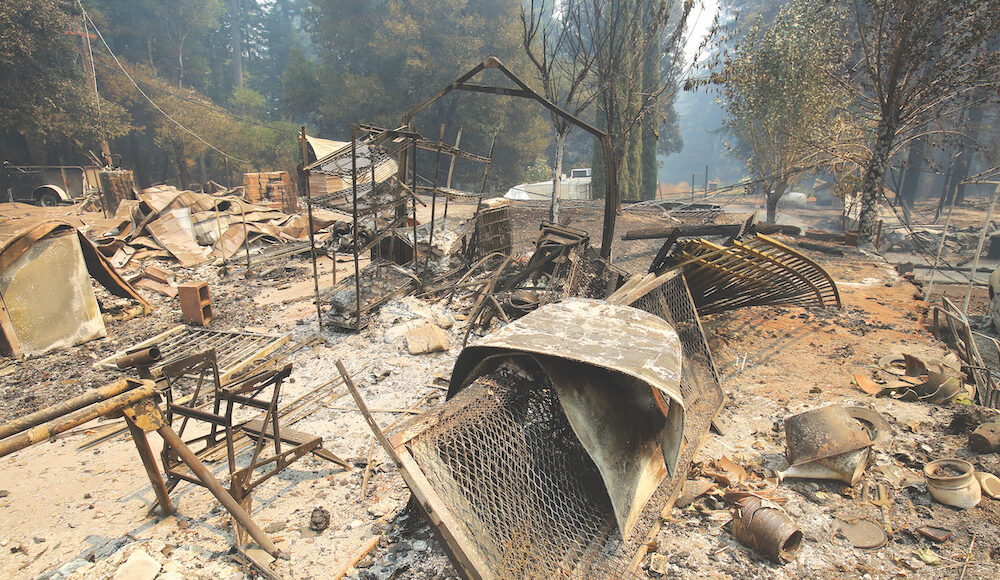Two women near the public comment podium hugged following a contentious item before the Santa Cruz County Board of Supervisors Tuesday afternoon, as it reversed course on a move that would have affected the property papers of many rebuilding after the CZU Lighting Complex fires.
At first, some in the crowd that had descended from the San Lorenzo Valley weren’t quite sure what the unanimous decision actually meant, so Fifth District Supervisor Bruce McPherson spoke up.
“The long and short of it is we eased the covenant,” he said.
The supervisors are caught in a tightrope act of paving the way for frustrated residents to rebuild while protecting people from falling victim to a future disaster. The rugged terrain in the Santa Cruz Mountains means landslides are a real concern, particularly in the wake of a forest fire.
The CZU Lightning Complex destroyed 911 single-family homes, three multi-family structures and 148 commercial or mixed-use structures in Santa Cruz County, according to county staff. Approximately 90 additional residences were damaged.
After the majority of flames were extinguished, the Watershed Emergency Response Team (WERT) issued a rapid response assessment in October 2020, followed by the more-detailed Boulder Creek Post-WERT Study by the California Geological Survey in November. Both identified the need for the County to obtain additional information to assess risk areas more fully, staff wrote in its report.
A few months later, residents were forced to evacuate, again, as an atmospheric river sent pounding rain to the region, sparking fears of shifting earth that largely didn’t materialize.
Community Foundation Santa Cruz County funded a $200,000 study, completed by the Atkins group, an engineering and project management firm that was acquired by SNC-Lavalin in July 2017.
Atkins, which has worked on the Dubai Opera and Heathrow Airport, brought its analysis tools to bear on Santa Cruz County’s geology and hydrology.
On Sept. 14, before the report had been completed, the Board of Supervisors approved a directive that let eligible property owners skip the “site-specific geological report” step in the rebuilding process to promote the issuing of building permits. The catch was that the property owner’s title would feature a “declaration of covenant” that includes “an assumption of risk, indemnification of the County, and disclosure to future property owners of unknown geologic hazards.”
Local residents weren’t too thrilled about this plan, which was presented via a “sample” covenant.
“Members of the public have voiced opposition to recording such a covenant,” staff wrote, adding officials are looking into how this would impact financing and insurance. “The language in the sample covenant discloses that a geologic report was not prepared, geologic hazards have not been characterized, and mitigations have not been identified, resulting in a potentially substantial but unknown level of risk that is being accepted by the Permitee.”
But now, The Atkins Debris Flow—Flood Hazard Study for the 2020 CZU August Lighting Complex Fires report refines the “hazard zones,” and provides information that “will facilitate revision of the sample covenant document to make it less broad, and closer in format and content to the standard Declaration of Geologic Hazard that has been in use for many years,” according to the staff report submitted by Acting Planning Director, Paia Levine.
Many homeowners have faced seemingly endless roadblocks to rebuilding, from the requirement to remove toxic materials to concerns about sewage systems being too close to waterways.
Being told they couldn’t build somewhere they used to live, without changing their ownership documents in a way that could devalue their property or make it hard to sell—because of some high-level report—felt like another thorn in the side for some.
“I know it’s been a frustrating experience,” McPherson said, adding the time had come to make adjustments. “Let’s just get back to the basics.”
A parade of community members took to the microphone—mostly in person—voicing their worries, and downright exasperation, at the snail’s pace of post-wildfire reconstruction.
“Please support our neighbors who lost their houses,” said a Boulder Creek woman whose house did not burn down, speaking up for fellow locals. “It’s nothing short of a miracle that Boulder Creek wasn’t completely destroyed.”
Katie Webb, the Swanton representative on the Davenport/North Coast Association Board, zeroed in on purported “inconsistencies” in the Atkins report for that part of the county.
In the end, the supervisors voted to accept the Atkins report, although they did tell staff to look at the section Webb was talking about, to make sure any problems were fixed.
But that wasn’t the only CZU-related discussion at the regularly scheduled meeting.
In addition, McPherson asked State Senator John Laird to check on firefighting helicopters supposedly stuck in Orange County, and find out if they could be used for night operations.
Laird replied that he’s working to make sure districts in California don’t hold their firefighters back from helping areas in need, as occurred when the San Lorenzo Valley burned. And he’s trying to get the state to “rejigger” its rules to make it easier for prisoners to fight fires, he added.
The Board of Supervisors also voted to write a letter to Cal Fire requesting that an After-Action Review (AAR) of the State’s response to the CZU Lighting Complex be conducted and provided and, if the request is declined, ask Cal Fire officials to explain why they won’t do it. Supervisors McPherson and Ryan Coonerty had proposed this idea.
“The County conducted a review of County Fire’s operations pertaining to the CZU fire,” staff noted. “However, Cal Fire did not conduct a full AAR.”
The report is not meant to punish, but rather to improve the community’s ability to respond to future fire events, according to the staff report.County officials included an example after-action report the National Parks Service did for the Carr Fire, to demonstrate to supervisors how helpful such a document can be in identifying issues, successes and challenges in the aftermath of a wildfire.













